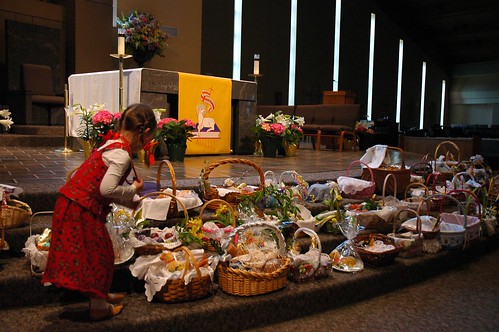Niedziela Palmowa in Poland! Posted by Kasia on Mar 29, 2015 in Culture, Religion
Today is Palm Sunday (Niedziela Palmowa). It marks the official beginning of Poland’s Easter festivities – perhaps the country’s most sacred holiday. Leading up to the season you’ll see decorative handmade palms (palmy) for sale almost everywhere in Poland. These traditional decorations made from a variety of dried flowers and plants are crafted in villages all over Poland. Palms are taken to church on Sunday to be blessed before decorating homes for the duration of the season.
As a deeply Catholic country, Poland takes its Easter celebrations seriously; throughout the period, the visiting foreigner can expect large shops and shopping malls and many bars and restaurants to be either empty or closed beginning on Good Friday (Wielki Piątek). A traditional day of abstinence, dutifully observing Catholics visit church to attend stations of the cross (droga krzyżowa) – a series of prayers following Jesus Christ’s route to his crucifixion.
On Easter Saturday (Wielka Sobota) Poles, typically children, bring brightly decorated baskets of food to church to have them blessed. These baskets traditionally contain a piece of sausage (kawałek kiełbasy), bread (chleb), egg (jajko), mazurek cake (a traditional Easter cake), some salt (sól), pepper (pieprz), some horseradish (chrzan) and a symbolic ram made from dough (symboliczny baranek z ciasta). In addition ‘pisanki’ are included – painted boiled eggs which have been prepared in the lead-up to Easter by the whole family. Each of these components of the basket has a symbolic meaning. The eggs and meat symbolise new life, fertility and health, the salt protects against bad spirits and helps you follow the right path, the bread symbolise the body of Christ and by this future prosperity in terms of always having food to feed yourself, the horseradish represents strength and physical health and the cake represents skills and talents needed for the coming year. Rezurekcja (Resurrection), a traditional mass with procession, is held Saturday night or Easter morning depending on parish tradition.
On Easter Sunday (Niedziela Wielkanocna), families gather together to celebrate with an Easter breakfast of żurek (Polish rye soup), bread, eggs, sausage, horseradish and poppy seed cakes. Each person places a small piece of the blessed food on their plate before exchanging wishes with other members of the family. The symbolic dough ram is placed on the table to symbolise the resurrection of Christ.
Things take a more light-hearted twist on Easter Monday. Known as Śmingus Dyngus, the day is dominated by public water fights and everyone is given carte blanche to drench anyone they see with water. You, as a foreigner, are not exempt from this practise, so move fast if you see someone armed with a water pistol or bucket and a grin. Although it’s never pleasant to have a jug of water thrown over your head, this is an improvement from the past when young people were beaten with sticks from Palm Sunday trees – explained away as bringing luck and strength for the year ahead.
Happy Easter to all of you!
Do następnego razu… (Till next time…)

Build vocabulary, practice pronunciation, and more with Transparent Language Online. Available anytime, anywhere, on any device.
About the Author: Kasia
My name is Kasia Scontsas. I grew near Lublin, Poland and moved to Warsaw to study International Business. I have passion for languages: any languages! Currently I live in New Hampshire. I enjoy skiing, kayaking, biking and paddle boarding. My husband speaks a little Polish, but our daughters are fluent in it! I wanted to make sure that they can communicate with their Polish relatives in our native language. Teaching them Polish since they were born was the best thing I could have given them! I have been writing about learning Polish language and culture for Transparent Language’s Polish Blog since 2010.





